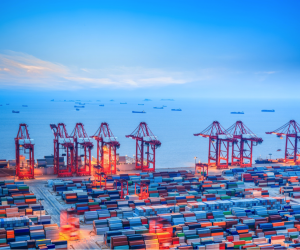What Will the 2020 Peak Season Look Like?

We’re fast approaching what’s known as the peak season for international shipping. Traditionally, August and September are huge months for the international shipping industry as retailers stock up for the holiday shopping season. Often, things start revving up in July and continue to be strong through November and even into December. However, 2020 is not a typical year. Some have even suggested it won’t have a peak season at all.
Can we even make any predictions about the peak season in a year when it seems like all predictions have turned out to be wrong? After all, the big story this year was supposed to be compliance with the new cleaner fuel mandates of IMO 2020 not shutdowns caused by a pandemic. Then all the shipping news outlets started running stories about how ocean carriers would lose billions of dollars in 2020 because of the novel coronavirus – based on analysis from shipping research experts, of course – yet carriers turned that around to likely make billions by year’s end..
Despite all of this years unpredictability, there are expectations we can now have for the 2020 peak season. Keep reading to find out what the 2020 peak season will likely look like.
Carriers Give Us Peak Season Prices Early
In a year marked by shutdowns and steep declines in demand, one would think freight rates would drop. However, ocean carriers have thwarted the downward freight rate pressure that comes with lower demand by shrinking supply.
I won’t spend a long time on this because we’ve covered it in previous blogs, but carriers have cancelled hundreds of sailings this year and continue to blank sail, dramatically decreasing capacity. Thus, it’s not as though the laws of supply and demand don’t apply this year, carriers simply decreased the supply end as fast or faster than COVID-19 shutdowns shrunk demand.
The result has been much higher freight rates in 2020 than in 2019 and many other years. We’ve already seen freight rates at levels that wouldn’t be expected until a strong peak season hit. Carriers have also had the discipline not to undercut each other’s rates – something they’ve often done in past years, causing rates to fall even during peak season – while continuing to manage low capacity.
If you read our blog post from last Tuesday, you’d know importing from China to the U.S. west coast was almost twice as expensive leading into that week as it was the same time last year:
Using the Shanghai Containerized Freight Index (SCFI), Mike Wackett reports in the Loadstar that Asia-US west coast spot rates were up last week 93% from the same week a year prior. For Asia-Europe, there’s a less massive but still very respectable year-on-year increase of 30%.
This week, Mike Wackett reports in the Loadstar that carriers are maintaining those rates. In fact, Asia-U.S. west coast even ticked up a little.
There’s good reason to believe carriers will continue to maintain high freight rates in these upcoming peak season months. Carriers have maintained good rate and capacity discipline not only all through 2020 but also through 2019. It’s possible that carriers have turned a corner when it comes to discipline.
General Rate Increases & Peak Season Surcharges
The General Rate Increase (GRI) and Peak Season Surcharge (PSS) are hallmarks of the peak season. Of course, discipline from ocean carriers is necessary to maintain these price hikes. As already mentioned, discipline has been a problem for carriers in the past but is something they’re currently doing well with. And, boy, have we seen GRIs piling up as a result.
As a matter of fact, the Journal of Commerce just ran an article by Bill Mongelluzzo about Trans-Pacific carriers issuing a whopping three GRI in a single month’s time!
With signs of US imports from Asia recovering, trans-Pacific carriers on Wednesday will impose a highly unusual third general rate increase (GRI) in one month’s time. Importers and forwarders say carriers, who filed July 1 GRIs as high as $1,500 with US regulators, this week are quoting figures between $250 and $800 per FEU.
There’s nothing new about carriers levying such charges as the summer-fall peak shipping season for retailers approaches. However, carriers already implemented GRIs on June 1 and June 15, so the July 1 increase will be the third in one month, an unusual occurrence even during periods of high demand. Carriers and their customers told JOC.com rates will continue to rise even though volumes are down almost 10 percent from the first five months of 2019, according to PIERS, a JOC.com sister company within IHS Markit.
On top of the GRIs, carriers are already talking about PSS too. This is the kind of thing you’d expect heading into a strong peak season rather than a weak or non-existent one.
Lower-Than-Normal Volumes But Still a Peak Season
Despite the warnings for most of the year that 2020 will not see a rebound in demand or a recovery for retailers, that does not mean we will see no peak season.
It is unlikely volume numbers will be anywhere near as high as they would have been had the novel coronavirus pandemic not struck; however, there is still demand for products as the holiday shopping season approaches. E-commerce has increased during this time and continues during the slow economic reopening process. Spiking and falling numbers of infections will make reopening uneven and in some places solidly delayed, but there is a strong signal from carriers that demand is coming back (other than the PSS and GRIs): less blank sailing.
I mentioned above that blank sailings are continuing from carriers, but we’re finally starting to see a significant drop in these cancellations just as we’re heading into peak season months.
According to that same JOC article mentioned above, citing Sea-Intelligence, carriers have only announced four blank sailings for July and August. This does not mean more won’t be announced, but it is a significant slow-down in blank sailing from what we’ve seen this year. It signals expectation of volume increase from carriers. In fact, carriers are even saying they’re starting to see movement toward recovery.
Mongelluzzo went on to report in his JOC article:
… Rolf Habben Jansen, CEO of Hapag-Lloyd, told JOC Uncharted he is starting to see encouraging signs of a recovery in the major east-west trades.
“We are experiencing a slow recovery into Q3 and a little bit more in Q4. I certainly see more encouraging signs today than four or six weeks ago,” he said.
Conclusion
While volume levels do not look to be as high as in years past, there will be a peak season as recovery is slowly taking place. If carriers can maintain the kind of discipline they’ve displayed throughout the year and for a while before, freight rates will be as high as in a strong peak season year with plenty of PSS and GRIs.
It can never be completely assumed that carriers won’t fall into old habits, making moves to grab market share from competitors. If that happens, a sudden drop in freight rates could take place. We’ve seen it happen before during peak seasons, but carriers do appear more dedicated than ever toward maintaining higher rates.
E-commerce has barely been mentioned above, but the important factor it is playing in international shipping demand is something we will get into in a future blog.




